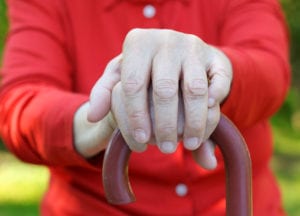Written by Tatjana Djakovic, Staff Writer. This article discusses the herb, Cat’s Claw, native to rain forests of Peru which was found to significantly decrease painful and tender arthritic joints.
 Rheumatoid arthritis is an inflammatory disorder in which the body attacks its own joints resulting in chronic pain, stiffness and a loss of movement. The disorder usually occurs between the ages of 30 to 50 years old and is responsible for 250,000 hospitalizations and 9 million physician visits in the U.S. each year. It is not clear how rheumatoid arthritis arises, but it is believed that environment and genetics play a role in initiating a trigger event which begins the joint inflammation 1. The treatment of rheumatoid arthritis involves use of nonsteroidal, anti-inflammatory drugs which reduce pain and swelling but also have risks such as gastrointestinal bleeding 2. It has been reported that up to 40% of rheumatology patients turn to alternative medicine due to failure of the standard medication to provide improvement in their condition 3.
Rheumatoid arthritis is an inflammatory disorder in which the body attacks its own joints resulting in chronic pain, stiffness and a loss of movement. The disorder usually occurs between the ages of 30 to 50 years old and is responsible for 250,000 hospitalizations and 9 million physician visits in the U.S. each year. It is not clear how rheumatoid arthritis arises, but it is believed that environment and genetics play a role in initiating a trigger event which begins the joint inflammation 1. The treatment of rheumatoid arthritis involves use of nonsteroidal, anti-inflammatory drugs which reduce pain and swelling but also have risks such as gastrointestinal bleeding 2. It has been reported that up to 40% of rheumatology patients turn to alternative medicine due to failure of the standard medication to provide improvement in their condition 3.
Cat’s claw (Uncaria tomentosa) is a giant vine with curved thorns, found in the rain forest of Peru which has been reported to treat arthritis, cancer, asthma, stomach ulcers and inflammation 4. Researchers initiated a double-blind placebo controlled randomized study to evaluate the effectiveness of cat’s claw extract in patients with active rheumatoid arthritis. The study consisted of 40 patients aged 20 years or more that have been diagnosed with rheumatoid arthritis and were permitted to take non-steroidal and steroidal anti-inflammatory medications up to 10 mg/day while in the study. The clinical assessment was always performed by the same physician at all the time points of the study, which was carried out at Rheumatological Outpatient Unit of Inssbruck University Hospital.
The study was divided into two phases:
Phase 1 (Weeks 0-24): Patients received one capsule of plant extract or placebo 3 times daily.
Phase 2 (Weeks 24-52): All patients received the plant extract.
| Time | Tender joints (number) | Swollen Joints (number) | Ritchie index (measurement of joint tenderness) | Morning stiffness (grade) |
|---|---|---|---|---|
| Phase 1: Cat' Claw | ||||
| Week 0 | 7.7 | 6.9 | 5.5 | 2.3 |
| Week 24 | 3.6 | 6.1 | 2.9 | 1.2 |
| Week 52 | 2.5 | 5.1 | 2.4 | 1.5 |
| Percent Change | 67.5% | 26.1% | 56.6% | 47.8% |
| Phase 2: Placebo | ||||
| (Week 0-24) | ||||
| Week 0 | 8.3 | 6.5 | 4.6 | 2.3 |
| Week 24 | 6.3 | 5.6 | 4.2 | 1.6 |
| Percent Change | 24.0% | 13.8% | 8.6% | 30.4% |
| (Week 24-52) (Cat’s Claw was given) | ||||
| Week 52 | 2.7 | 3.1 | 1.8 | 1.1 |
| Percent Change | 67.5% | 52.3% | 60.8% | 52.2% |
The changes were significant as indicated by the p<0.01.
The comparison of the two groups shows that at the end of the first phase of the study, patients in the plant extract group had fewer painful joints than those of the placebo group (reduction by 53.2 versus 24.1%; p = 0.044). In patients given the plant extract, there was a reduction in the number of tender joints (p = 0.001), Ritchie Index (p= 0.002), and duration of morning stiffness (p = 0.002) after 24 weeks while much lower reductions were seen in the placebo group.
In phase 2, patients that were originally taking placebo treatment started taking cat’s claw after week 24. After 52 weeks, there was a significant reduction in the parameters (number of painful joints (p = 0.003), number of swollen joints (p = 0.007), and Ritchie Index (p = 0.004) compared to the values observed at the end of their placebo treatment. Additionally, there was 31.2% reduction in pain after 52 weeks of cat’s claw treatment (p<0.01).
The current study is indicative of the association between intake of cat’s claw and reduction in rheumatoid arthritis associated symptoms, although a larger study would yield more conclusive results.
Source: Mur, Erich, et al. “Randomized double blind trial of an extract from the pentacyclic alkaloid-chemotype of uncaria tomentosa for the treatment of rheumatoid arthritis.” The Journal of rheumatology 29.4 (2002): 678-681.
© 2016 by The Journal of Rheumatology Publishing Company Limited
Posted September 16, 2013.
References:
- Majithia V, Geraci SA. Rheumatoid arthritis: diagnosis and management. Am J Med. 2007;120(11):936-939.
- Laporte JR, Ibanez L, Vidal X, Vendrell L, Leone R. Upper gastrointestinal bleeding associated with the use of NSAIDs: newer versus older agents. Drug Saf. 2004;27(6):411-420.
- Vecchio PC. Attitudes to alternative medicine by rheumatology outpatient attenders. J Rheumatol. 1994;21(1):145-147.
- Valerio LG, Jr., Gonzales GF. Toxicological aspects of the South American herbs cat’s claw (Uncaria tomentosa) and Maca (Lepidium meyenii) : a critical synopsis. Toxicol Rev. 2005;24(1):11-35.
